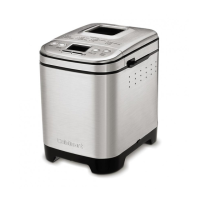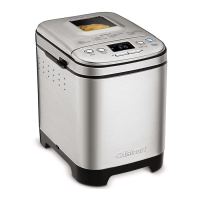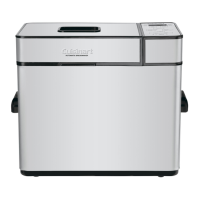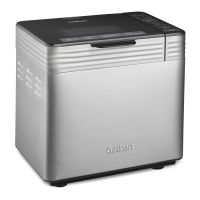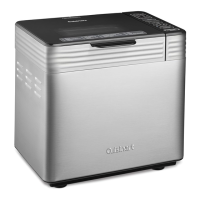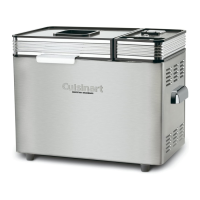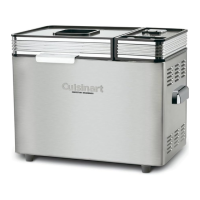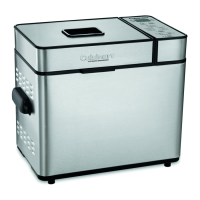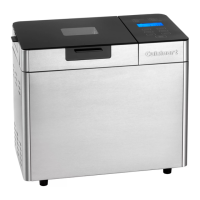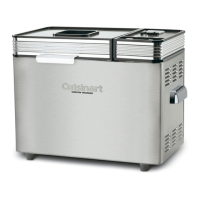Do you have a question about the Cuisinart BMKR-200 Series and is the answer not in the manual?
Displays loaf size, crust color, current function, menu selection, and delay timer.
Allows selection of loaf size: 1lb, 1½ lb, or 2lb.
Enables selection of desired crust color: light, medium, or dark.
Used to select the desired program from the available list.
Activates the 12th pre-programmed setting for faster bread baking.
Allows setting a delayed start time for the bread making process.
Initiates and halts the bread making process.
Instructions for unpacking, cleaning, and preparing the bread maker.
Steps for preparing the bread pan and adding ingredients before baking.
Guide to selecting loaf size, crust color, and program for baking.
Options for immediate start or delayed start of the bread making process.
Details the stages: Preheat, Knead, Rest, Rise, Bake, Keep Warm, End.
Details on adding mix-ins and post-kneading options.
Description of cycles for white and French/Italian bread types.
Information on making bread with a significant portion of whole wheat flour.
Details on programs for sweet breads and gluten-free options.
Guidance for using bread mixes and baking cake or quick breads.
Preparation of dough for baking outside the bread maker.
Instructions for preparing pasta dough using the bread maker.
Using the bread maker for making homemade jams and chutneys.
Activating the bread maker solely for baking, with adjustable time intervals.
Utilizing rapid rise yeast for faster bread baking cycles.
Key guidelines for accurate measurement of ingredients for successful baking.
A chart providing common conversions for baking measurements.
Ensures ingredients are added in the exact sequence for optimal results.
Importance of room temperature ingredients for proper bread rising.
Emphasis on the critical role of fresh flour and yeast.
Influence of temperature and humidity on dough consistency and results.
Guidance on adjusting ingredients based on dough texture.
Tips for easier removal of the kneading paddle after baking.
Caution against using the delay timer with fresh dairy or eggs.
Importance of accurate ingredient preparation before adding to the pan.
Specific order for adding ingredients like liquids, sugars, and yeast.
Ideal ingredient temperatures (75°-90°F) for optimal bread machine baking.
Benefits of vital wheat gluten for improving loaf height and structure.
Timing for adding nuts, seeds, fruits, and other additions.
Procedure for reshaping dough for a more uniform loaf shape.
Best used for breads with whole wheat or other heavy flours.
Recommended cooling time for loaves before slicing for best results.
Recommendation to use bread flour for white breads due to higher protein content.
A general formula for a 1½-pound bread machine loaf.
Relationship between flour quantity and final loaf weight.
Guidance on substituting eggs when mathematical measurements are fractional.
Steps for cleaning the bread maker, including housing and control panel.
Instructions for cleaning the lid, advising against dishwasher use.
How to clean the baking pan, kneading paddle, and measuring accessories.
Causes and solutions for dough failing to rise, including yeast and liquid issues.
Reasons for short loaves, such as insufficient sugar or yeast.
Addressing loaves with an open texture due to too much yeast or wet dough.
Solutions for dense loaves caused by dry dough or incorrect ingredient substitutions.
Tips for removing the kneading paddle before or after baking.
Factors affecting loaf shape, including humidity and ingredient proportions.
Addressing issues like underbaking, gummy texture, or collapsed loaves.
Causes and cleaning advice for smoke or burning smells from the machine.
Details of the warranty coverage, duration, and consumer rights.
Instructions on how to contact Cuisinart for repair or replacement.
Items not covered by the warranty, such as misuse or unauthorized parts.
Specific consumer rights and options for warranty service in California.
Displays loaf size, crust color, current function, menu selection, and delay timer.
Allows selection of loaf size: 1lb, 1½ lb, or 2lb.
Enables selection of desired crust color: light, medium, or dark.
Used to select the desired program from the available list.
Activates the 12th pre-programmed setting for faster bread baking.
Allows setting a delayed start time for the bread making process.
Initiates and halts the bread making process.
Instructions for unpacking, cleaning, and preparing the bread maker.
Steps for preparing the bread pan and adding ingredients before baking.
Guide to selecting loaf size, crust color, and program for baking.
Options for immediate start or delayed start of the bread making process.
Details the stages: Preheat, Knead, Rest, Rise, Bake, Keep Warm, End.
Details on adding mix-ins and post-kneading options.
Description of cycles for white and French/Italian bread types.
Information on making bread with a significant portion of whole wheat flour.
Details on programs for sweet breads and gluten-free options.
Guidance for using bread mixes and baking cake or quick breads.
Preparation of dough for baking outside the bread maker.
Instructions for preparing pasta dough using the bread maker.
Using the bread maker for making homemade jams and chutneys.
Activating the bread maker solely for baking, with adjustable time intervals.
Utilizing rapid rise yeast for faster bread baking cycles.
Key guidelines for accurate measurement of ingredients for successful baking.
A chart providing common conversions for baking measurements.
Ensures ingredients are added in the exact sequence for optimal results.
Importance of room temperature ingredients for proper bread rising.
Emphasis on the critical role of fresh flour and yeast.
Influence of temperature and humidity on dough consistency and results.
Guidance on adjusting ingredients based on dough texture.
Tips for easier removal of the kneading paddle after baking.
Caution against using the delay timer with fresh dairy or eggs.
Importance of accurate ingredient preparation before adding to the pan.
Specific order for adding ingredients like liquids, sugars, and yeast.
Ideal ingredient temperatures (75°-90°F) for optimal bread machine baking.
Benefits of vital wheat gluten for improving loaf height and structure.
Timing for adding nuts, seeds, fruits, and other additions.
Procedure for reshaping dough for a more uniform loaf shape.
Best used for breads with whole wheat or other heavy flours.
Recommended cooling time for loaves before slicing for best results.
Recommendation to use bread flour for white breads due to higher protein content.
A general formula for a 1½-pound bread machine loaf.
Relationship between flour quantity and final loaf weight.
Guidance on substituting eggs when mathematical measurements are fractional.
Steps for cleaning the bread maker, including housing and control panel.
Instructions for cleaning the lid, advising against dishwasher use.
How to clean the baking pan, kneading paddle, and measuring accessories.
Causes and solutions for dough failing to rise, including yeast and liquid issues.
Reasons for short loaves, such as insufficient sugar or yeast.
Addressing loaves with an open texture due to too much yeast or wet dough.
Solutions for dense loaves caused by dry dough or incorrect ingredient substitutions.
Tips for removing the kneading paddle before or after baking.
Factors affecting loaf shape, including humidity and ingredient proportions.
Addressing issues like underbaking, gummy texture, or collapsed loaves.
Causes and cleaning advice for smoke or burning smells from the machine.
Details of the warranty coverage, duration, and consumer rights.
Instructions on how to contact Cuisinart for repair or replacement.
Items not covered by the warranty, such as misuse or unauthorized parts.
Specific consumer rights and options for warranty service in California.
| Model | BMKR-200 Series |
|---|---|
| Category | Bread Maker |
| Preprogrammed Cycles | 12 |
| Crust Settings | Light, Medium, Dark |
| Gluten-Free Setting | Yes |
| Rapid Bake Cycle | Yes |
| Delay Start Timer | Yes |
| Keep Warm Function | Yes |
| Display | LCD |
| Viewing Window | Yes |
| Power | 600 watts |
| Capacity | 2 lb |

